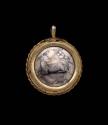Advanced Search
Marriage Pendant
Italian (Florence)
about 1455–65
Object Place: Europe, Florence, Italy
Medium/Technique
Silver-gilt, niello
Dimensions
Other (Overall): 4.1 x 1.2 cm (1 5/8 x 1/2 in.)
Credit Line
H. E. Bolles Fund
Accession Number69.74
ClassificationsJewelry / Adornment – Pendants
Italian Renaissance jewelers from the mid-fifteenth to the sixteenth century produced large numbers of double-sided niello pendants. This one consists of back-to-back niello plaques set in a silver-gilt frame with a twisted-cord motif. The front features engraved facing portraits of a finely dressed young couple against a background of a fruited vine. The bountiful foliage represents the tree of life and suggests that the ornament was intended for an engaged or married woman.1 Similar representations appear on rings, majolica pottery, and glass objects from the same period.2
The medallion’s reverse illustrates the Lamb of God (Agnus Dei), with the haloed lamb resting on a book and looking back at a cross. Niello containers with similar imagery are believed to have originated in the fourteenth century, when popes gave them out as protective, talismanic ornaments. Wax renderings of the lamb or relics of a saint or other religious artifacts were placed inside these adornments.3 The Agnus Dei on the reverse of this marriage pendant may have served to protect its wearer during pregnancy, childbirth, and illness
Yvonne J. Markowitz, “Marriage Pendant” in Artful Adornments: Jewelry from the Museum of Fine Arts, Boston by Yvonne J. Markowitz (Boston: MFA Publications, 2011), 107.
The medallion’s reverse illustrates the Lamb of God (Agnus Dei), with the haloed lamb resting on a book and looking back at a cross. Niello containers with similar imagery are believed to have originated in the fourteenth century, when popes gave them out as protective, talismanic ornaments. Wax renderings of the lamb or relics of a saint or other religious artifacts were placed inside these adornments.3 The Agnus Dei on the reverse of this marriage pendant may have served to protect its wearer during pregnancy, childbirth, and illness
Yvonne J. Markowitz, “Marriage Pendant” in Artful Adornments: Jewelry from the Museum of Fine Arts, Boston by Yvonne J. Markowitz (Boston: MFA Publications, 2011), 107.
DescriptionNielloed medallions set into silver-gilt case with rope molding and loop for hanging. Obverse: the couple facing one another, tree of life between them. Reverse: Lamb of Christ lying on book
ProvenanceDr. Hermann Freund (b. 1883), Vienna [see note 1]. 1969, sold by Leopold Blumka (dealer), New York, to the MFA. (Accession Date: May 14, 1969)
NOTES:
[1] According to an annotation in the curatorial file.
NOTES:
[1] According to an annotation in the curatorial file.



